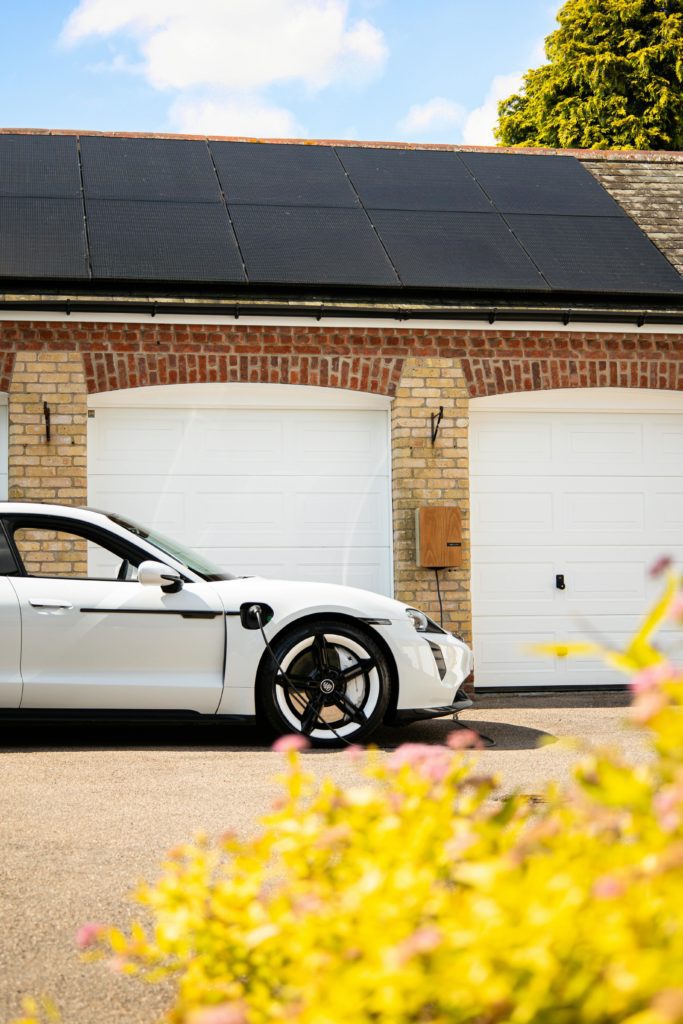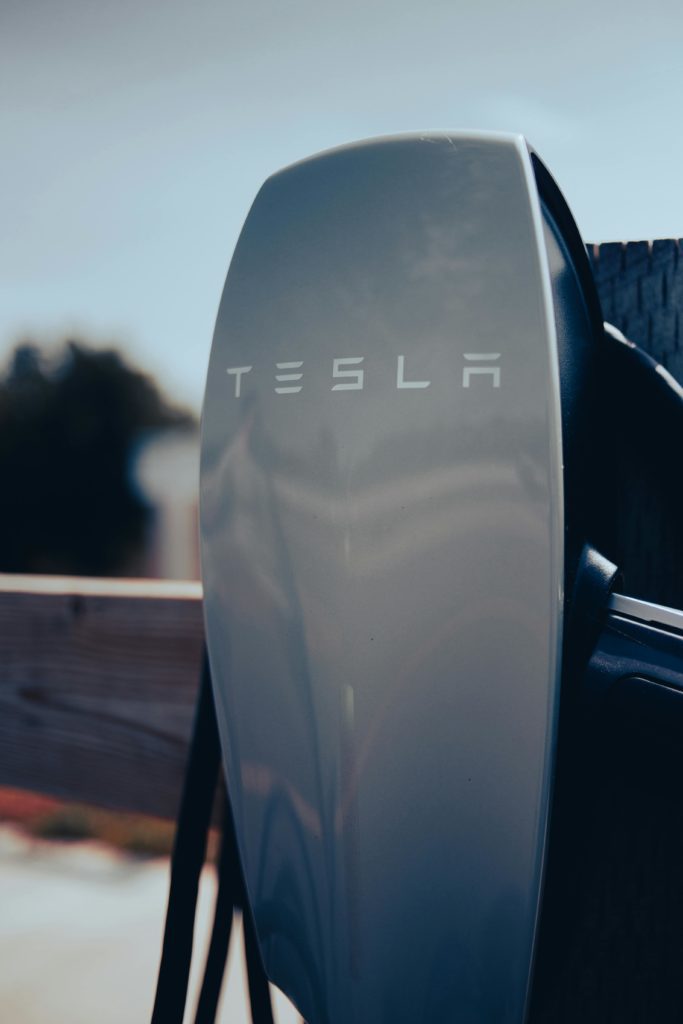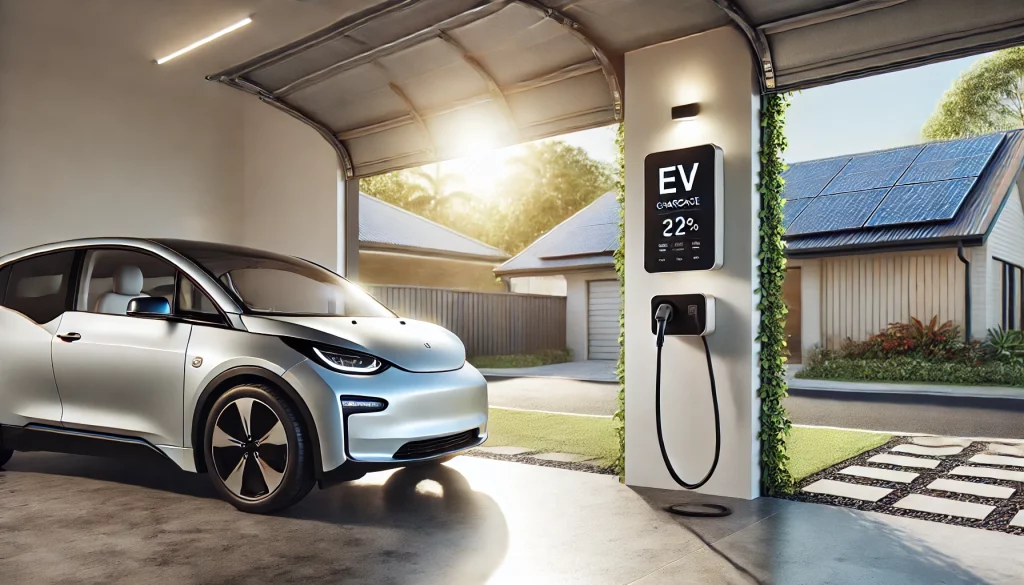In this article we estimate for a typical household with 15kWh daily usage, you will require around 14 x 400 watt solar panels (or a 5.6kW solar system) to cover almost 100% of your EV charging requirements. It’s important that you read the below guide to understand how this works for your specific energy usage and location.
Why Solar EV charging matters
Australia is already a leader in rooftop solar energy production: one in three homes are already enjoying free electricity generated directly by the sun. Because Australia has abundant sunlight, integrating solar panels with EVs is not only feasible but highly practical.
With interest in electric vehicles (EVs) on the increase as drivers seek to escape rising fuel prices and having to visit the petrol pump, combining EVs with solar charging is, quite simply, the obvious next step.
Solar EV charging can not only drastically reduce the cost of owning a car, it also offers homeowners a way to achieve energy independence, minimise environmental footprints and maximise the impact of solar energy production.
Ready to get an EV charger installation quote?
Compare quotes for an EV chargers from pre-vetted installers near you
How to Charge an EV at home with solar power
Using solar energy to power an EV requires an optimised system to ensure excess renewable energy is directed to the car’s lithium-ion battery. Solar feed-in tariffs are lower than ever before, so using that energy to power a car now makes more sense.
Solar panel system basics
Solar panels absorb sunlight and convert it into direct current (DC) electricity. An inverter then transforms DC power into alternating current (AC) for household use, including EV charging.
- Solar panel efficiency varies based on factors like location, orientation, and weather conditions.
- For optimal performance, panels generally should face north in Australia, although other configurations are possible depending on the house orientation and roof angle.
- Fixed tilt systems generally aim for a compromise that balances summer and winter energy generation.
- The optimal tilt for solar panels differs according to latitude. For example, the best tilt angle for a house in Darwin is 12–15° to capture more sunlight the year around, while a house in Hobart is better off with a 40–45° tilt because of the low angle of the sun in winter.
- There are also adjustable systems that allow seasonal retilting, improving performance in regions with significant seasonal differences (e.g. Southern Victoria and Tasmania).
Components of a solar EV charging system
- Solar Panels: Capture sunlight and generate electricity. Solar panels come in different wattages, typically ranging from 300W to 500W per panel. A higher wattage system generates more energy, supporting EV charging and household needs.
- Inverter: Converts the electricity from DC to AC.
- String inverters connect all solar panels to a single inverter. They are cost-effective but less efficient if shading affects even one panel.
- Microinverters are attached to individual panels, allowing independent performance. These are ideal for if shading is an issue or for complex layouts, for example panels on both the east and west of the building.
- Hybrid inverters manage both solar energy and battery storage, offering a seamless energy management solution.
- Smart inverters allow real-time energy monitoring and can prioritise energy distribution, ensuring surplus solar power is used for EV charging or battery storage.
- Solar-Optimised EV Charger:
- These chargers differ from standard EV chargers because they prioritise solar energy when available, reducing reliance on grid power.
- Some models adjust charging rates based on solar production, ensuring only excess energy production is used to charge the EV.
- Battery Storage (optional): Allows storage of excess energy, enabling nighttime charging when the sun isn’t shining. These chargers differ from standard EV chargers because they prioritise solar energy when available, reducing reliance on grid power.
- Energy Capacity: Energy storage batteries come in varying sizes, typically ranging from 5 kWh to 15 kWh or more.
- Cost Considerations: Batteries do increase system costs significantly (typically $8,000–15,000), government home battery rebates and long-term savings on electricity can offset this expense.
- Smart Battery Systems: Intelligent energy management systems coordinate with inverters to optimise energy flow, allow remote monitoring and can prioritise charging/discharging based on usage patterns.
Factors influencing solar panel requirements
Several factors impact how many solar panels are needed to charge an EV:
EV energy consumption
- EV Battery Size: While offering longer range, larger EV batteries are heavy and reduce vehicle efficiency.
- Vehicle Efficiency (kWh/100 km): How aerodynamic a car is also affects how efficiently it uses energy. Different models consume varying energy amounts. For instance:
- Tesla Model Y RWD: 16.5 kWh/100 km
- Hyundai Kona EV 65kWh: 16.8kWh/100 km
- Kia EV9 GT-Line: 22.6 kWh/100 km
| Annual energy requirements = EV efficiency (kWh/100km) x km driven per week / 100 x 52 Example: A Tesla Model Y driven 200 km per week requires 33 kWh per week, or approximately 1,716 kWh annually. |
- Driving Conditions and Style: How, where and when an EV is driven also impacts how much energy is needed. For example, driving in hilly terrain on a cold, wet and windy day will consume more energy than in city traffic on a dry, mild day.
- Household Energy Needs: Solar systems must account for both EV and household energy needs.It’s best to check your own power bills to determine how much your home uses throughout the year.
- On average, Australian households consume around 15–20 kWh/day, depending on location, appliances, and lifestyle.
- This can vary widely depending on number of appliances, cooling and heating, insulation and number of residents.
- A large, poorly insulated house that houses a large family and has a pool and other power-hungry devices will use more energy than a small, well-insulated house with fewer occupants.
- EV Charger Types: There are two types of EV chargers that can be used at home. What type of EV charger you use can impact the size of the solar system that is best for your usage.
- Level 1 Chargers: This refers to EV chargers that plug into standard power outlets.
- Level 2 Chargers: This refers chargers that are hardwired and require professional installation by an electrician but deliver faster, more efficient charging, ideal for solar systems.
- Charge Rate: A typical Level 1 charger on a household power outlet on a 240 volt/10 amp circuit draws 2.4kW maximum. A Level 2 charger on a 240 volt/32amp circuit can draw up to 7.7kW maximum.
Solar panel output across Australia
Average solar panel energy output depends on local sunlight hours and conditions. Note that seasonal changes and weather conditions such as overcast days can affect daily output. The table below shows average daily output (per 1 kW of panels) across Australian capital cities:
| City | Average Output (kWh/day) |
| Sydney | 3.9 |
| Melbourne | 3.6 |
| Brisbane | 4.2 |
| Perth | 4.4 |
| Adelaide | 4.2 |
| Hobart | 3.5 |
| Darwin | 4.4 |
| Canberra | 4.3 |
Ready to get an EV charger installation quote?
Compare quotes for an EV chargers from pre-vetted installers near you
How many solar panels do you need to charge an EV?
The number of panels required to power a household including charging an EV can be estimated by working our daily energy needs, then calculating how many panels are required depending on average output for the location, and output per panel.
| Solar Panels needed = (Annual EV energy needs + Annual household energy needs) Annual output per panel = Average daily output per 1kW panel × panel size in kW × 365 |
Example: Using the Tesla Model Y example from above, and assuming 400 watt panels will be used:
- Annual EV energy needs: 1,716 kWh
- Annual household daily energy needs: 15 kWh x 365 = 5,475 kWh
- Annual output per panels (Sydney): 3.9 kWh/day x 0.4 kWh x 365 = 584 kWh/year
- Panels Needed: 1716 + 5475 / 584 = 12.3
Since panels must be a whole number, 13 panels are needed, that is a 5.2 kW solar system.
Panels required for an average home using 15kWh energy per day:
| EV driving 230km a week | kWh/100 km | Annual kWh needed for EV | Panels needed (400w panels) | Total system output |
| Tesla Model Y | 16.5 | 1,716 | 13 | 5.2 kWh |
| Hyundai Kona EV | 16.8 | 1,748 | 13 | 5.2 kWh |
| Kia EV9 | 22.6 | 2,350 | 14 | 5.6 kWh |
Savings from using solar power to charge an EV
The most important questions for many is, “How much can you save by using your solar to charge an EV?”

There’s two ways to consider how can be saved by charging from solar:
- Compared to owning a Toyota RAV4 hybrid:
- Charging a Tesla Model Y to drive 200 km per week off solar costs $0
- Fuelling a Toyota RAV4 to drive 200km a week using 4.8l/100km petrol that costs $1.80 costs $17.28
- Over a year, charging the EV from solar saves $898
- Compared to charging from the grid
- Charging a Tesla Model Y to drive 200 km per week off solar costs $0
- Charging a Tesla Model Y to drive 200 km per week off the grid at an average of 30c/kWh costs $9.00
- Over a year, charging the EV from solar saves $468
Over time, the savings from using solar can be substantial, especially as electricity and fuel prices rise.
Environmental Savings
Switching to an EV powered by solar energy offers dramatic environmental benefits. Petrol vehicles, even hybrids like the Toyota RAV4, emit significant CO2 emissions due to their reliance on fossil fuels.
For instance, according to the Electric Vehicle Council’s Lifecycle emissions calculator, a medium electric SUV like the Tesla Model Y emits 124g CO2/km when charged off the grid, while a medium hybrid like the Toyota RAV4 emits 175g CO2/km.
The same data shows that a medium electric SUV charged off rooftop solar emits 73g CO2/km, assuming the vehicle is owned for 15 years and is driven 12,600km a year. These figures include the manufacturing of the vehicles and their batteries.
Therefore, the RAV4 Hybrid emits approximately 2.2 tons of CO2 annually whereas a grid-charged Tesla Model Y emits around 1.6 tons of CO2 over the same period of ownership.
Over a year, the switch from a hybrid to a solar-powered EV can save nearly 1.3 tons of CO2, equivalent to burning approximately 500 litres of petrol.
Benefits of charging EVs with solar panels
To summarise, the savings to be had from charging your EV from solar are many: from financial savings to reducing environmental impact to weaning off fossil fuels.
- Cost Savings
Solar-powered EV charging eliminates the need for petrol or grid electricity, significantly reducing ongoing costs. Unlike fluctuating fuel or electricity prices, solar energy offers consistent savings after the system pays for itself, making it an excellent long-term investment for EV owners.
- Environmental Impact
Charging EVs with solar minimizes greenhouse gas emissions, helping households reduce their carbon footprint while supporting Australia’s renewable energy goals. By replacing petrol vehicles with solar-powered EVs, families can avoid up to 2 tons of CO2 emissions annually, contributing to cleaner air and a healthier environment.
- Energy Independence
Pairing solar panels with battery storage enables households to generate, store, and use their energy independently. This means EVs can be charged even during grid outages or at night, providing freedom from rising electricity costs and energy security in unpredictable conditions.
Challenges and considerations
Of course, there are some challenges and other factors to take into account if making the switch to a solar-charged EV.
- Initial Investment
The upfront cost of installing a solar system and Level 2 charger can exceed AUD 10,000. However, government incentives and rebates can significantly reduce these costs, making the switch to solar more accessible for many households.
- Weather Dependence
Solar panel output varies with weather and seasons, meaning grid or battery backup is often necessary to maintain consistent EV charging, especially in regions with less sunlight or during winter months.
- Space Requirements
A solar system supporting average household needs and EV charging may require 13-15 panels, which can be a challenge for homes with limited roof space. Homes that use more energy may require even more roof space. High-efficiency panels can help reduce this requirement.
- System Compatibility
To ensure seamless integration, EV chargers should be compatible with the solar system, inverter, and batteries. Solar-optimised chargers further enhance efficiency by prioritising solar power for charging during peak generation hours.
Conclusion and key takeaways

When it comes down to it, charging your EV with solar power is a cost-effective, environmentally sustainable solution for Australian households.
For a Tesla Model Y driven 200 km weekly, 1 5.2kW system with 13 solar panels would suffice in a sunny location like Sydney. While the initial costs may seem steep, government incentives and long-term savings go towards making solar EV charging a worthwhile investment.
By adopting solar EV charging, homeowners not only reduce energy bills but also contribute to a cleaner, greener future.
Ready to get an EV charger installation quote?
Compare quotes for an EV chargers from pre-vetted installers near you
- Bidirectional EV Chargers Explained: V2G, V2H & V2L in Australia (2025 Guide) - 22 April, 2025
- How much does it cost to charge an EV in Australia? - 5 February, 2025
- How many solar panels do you need to charge an EV in Australia? - 4 February, 2025
